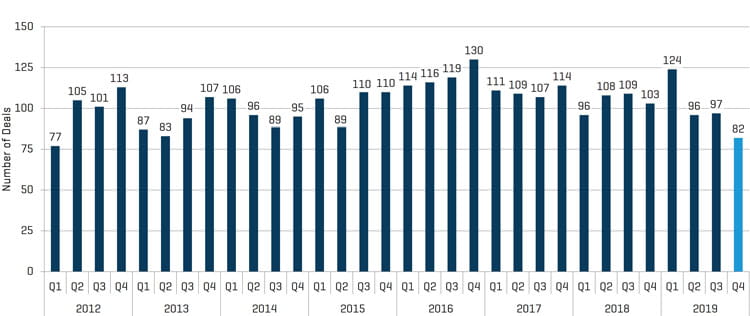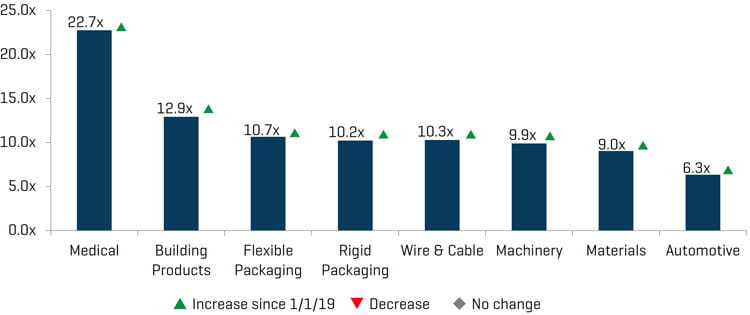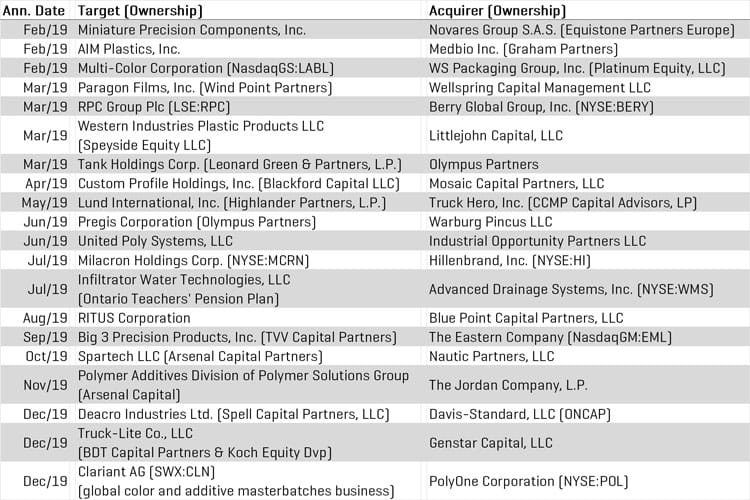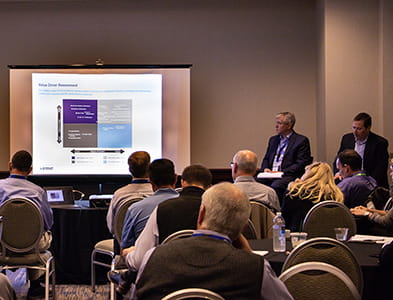Plastics Industry Update - 2019 Year in Review
Subscribe to Industry UpdatesPlastics Industry Update - 2019 Year in Review
Subscribe to Industry UpdatesPlastics M&A Activity Sees Slight Decline in 2019
There were 399 plastics industry M&A transactions in 2019, a 4% decrease relative to 2018. This decline was largely due to a 20% drop in fourth-quarter 2019 volume, year over year, as well as a decline in cross-border and international transactions. Despite the slightly lower activity, there continues to be significant interest in plastics companies across processes and end markets, particularly in the U.S. market. Industrial plastics led the charge during 2019 with an 8% increase, followed by automotive with a 5% increase, while medical and plastic packaging deals declined. From a process perspective, several smaller, ‘niche,’ categories saw increases with prototyping, machinery, and tool and die transactions increasing 133%, 29%, and 14%, respectively. From a seller’s perspective, privately held businesses saw a slight increase, while private equity and corporate carveout sales were down. From a buyer’s perspective, financial buyers acquiring businesses as new platforms increased 20%, while strategic and hybrid activity declined. In addition, there was a slight increase in domestic transactions, while cross-border and international transactions were down.
Key 2019 Themes
- Slightly lower plastics industry M&A activity, though slightly up in the U.S. market
- Stock markets and overall valuation levels remain at or near all-time highs
- Continued low cost of capital and high level of availability
- Key macroeconomic indicators remain strong
- Industrial and automotive transactions increased
- Demand for medical and packaging opportunities remains high
- Privately held plastics businesses saw increased M&A
- Niche processing segments saw significant increases, including prototyping, machinery, and tool and die
- Domestic plastics M&A activity increased
Stout Proprietary M&A Database Highlights
Buyer and Seller Trends
Financial buyer activity saw the biggest increase during 2019 with a 20% jump, driven largely by an increase in industrial transactions. Strategic and hybrid buyer plastic M&A activity decreased 12% and 6%, respectively, during 2019. On the sell side, private seller activity increased slightly at 0.4%, while private equity and corporate seller activity decreased 15% and 8%, respectively, during 2019.
End Market Activity
Industrial plastics M&A activity was the biggest driver during 2019 with an 8% increase. Within the industrial plastics segment, most process types were up, although injection molding, resin/compounding, machinery, and distribution were particular bright spots. While a smaller segment within plastics M&A, automotive activity also increased 5% during 2019. Medical plastics and plastic packaging, the second largest segment, ended with 37% and 16% declines, respectively, for the year. There is somewhat of a scarcity within medical and plastic packaging, which could be a contributor to the decline given that there continues to be high demand for these businesses.
Activity by Process
M&A activity involving seven out of the 10 plastic processes tracked by Stout were flat or up during 2019. Bright spots for the year included resin/compounding, machinery, tool and die, prototyping, and distribution.
Activity by Geography
Domestic plastics M&A activity saw a slight increase during 2019, up 1%. Cross-border and international plastics M&A activity was down 12% and 7%, respectively, for the year. Within the U.S. market, plastics M&A activity saw the biggest gains in the industrial and automotive end markets, as well as the injection molding, resin/compounding, machinery, and tool and die segments.
PLASTICS M&A VOLUME

Source: Stout and various sources
Market Trends
Plastics Industry Multiples
Strong stock market performance continued in 2019 with most public companies and indices, generally speaking, continuing to be at or near all-time highs. For 2019, the Dow was up approximately 22%, while the S&P 500 and Nasdaq were up 28% and 34%, respectively. Within the plastics industry, all public company segments continue to maintain relatively high valuation levels, with all eight plastics industry sectors that Stout tracks ending up for 2019.
Macroeconomic Metrics
Key macroeconomic indicators, including GDP, consumer confidence, unemployment and other metrics remained strong during 2019. Capital markets continue to be favorable for M&A activity and there remains a relatively low cost of capital environment. Crude oil prices increased 35% during 2019, while natural gas prices were down 26%. Resin pricing for commodity plastics generally declined during 2019, while engineering grade resins were generally flat.
EBITDA MULTIPLES (MEAN)

Source: Capital IQ and Proprietary Stout Indices
2019 TRANSACTION HIGHLIGHTS








